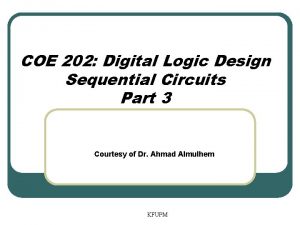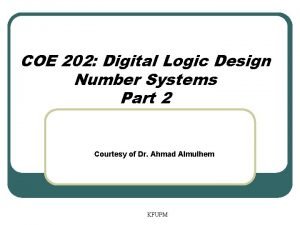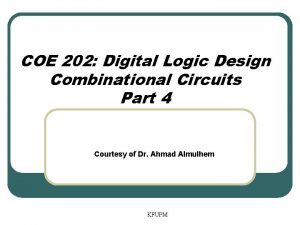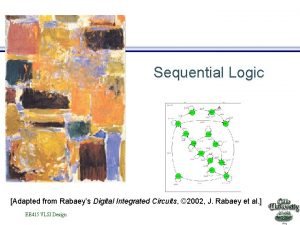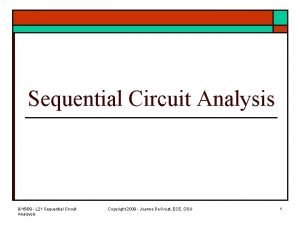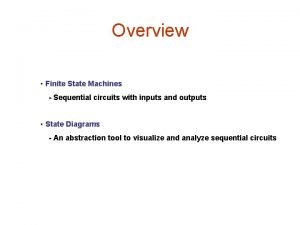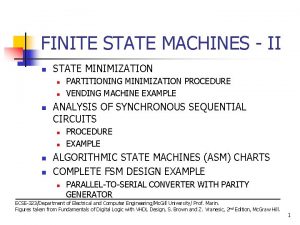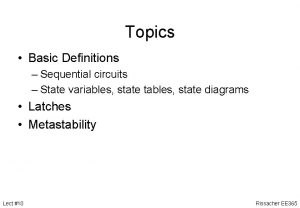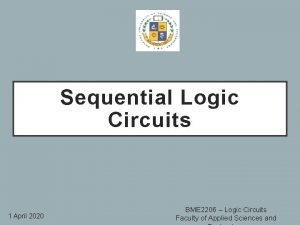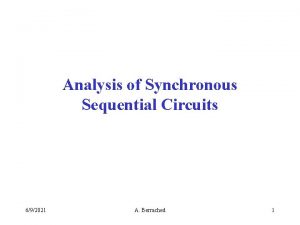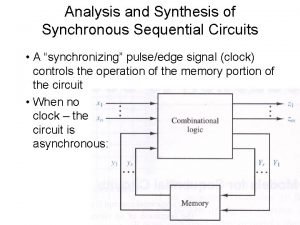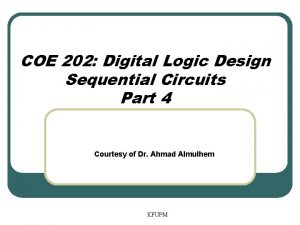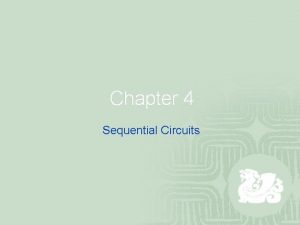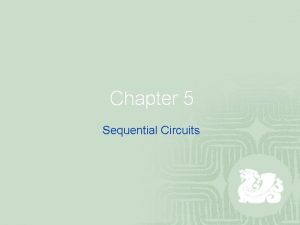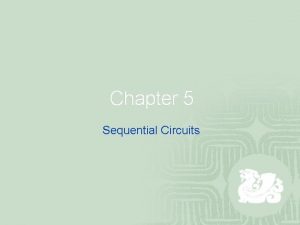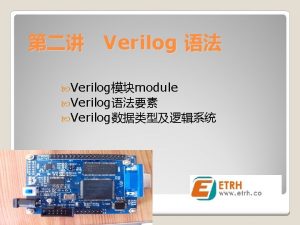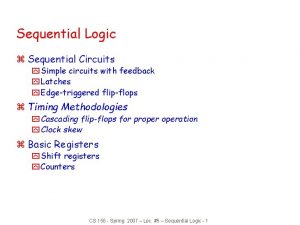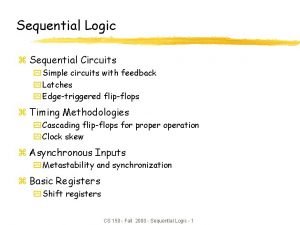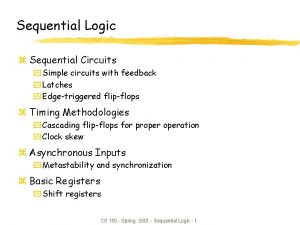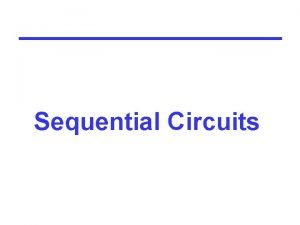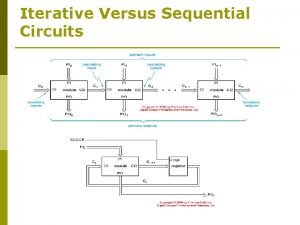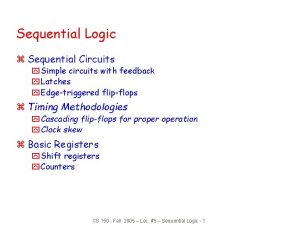Modeling Sequential Circuits in Verilog COE 202 Digital

























![Test Bench for the Up-Down Counter module Up_Down_Counter_TB; // Test Bench reg [7: 0] Test Bench for the Up-Down Counter module Up_Down_Counter_TB; // Test Bench reg [7: 0]](https://slidetodoc.com/presentation_image_h/37d77b92db5d42e82226c4759ad03e8b/image-26.jpg)

- Slides: 27

Modeling Sequential Circuits in Verilog COE 202 Digital Logic Design Dr. Muhamed Mudawar King Fahd University of Petroleum and Minerals

Presentation Outline v Blocking versus Non-Blocking Assignments v Modeling Latches and Flip-Flops v Modeling Sequential Circuit Diagrams v Modeling Mealy and Moore State Diagrams v Writing Test Benches for Sequential Circuits v Modeling Registers and Counters Modeling Sequential Circuits in Verilog COE 202 – Digital Logic Design © Muhamed Mudawar – slide 2

Procedural Assignment v Procedural assignment is used inside a procedural block only v Two types of procedural assignments: v Blocking assignment: variable = expression; // = operator Variable is updated before executing next statement Similar to an assignment statement in programming languages v Non-Blocking assignment: variable <= expression; // <= operator Variable is updated at the end of the procedural block Does not block the execution of next statements Modeling Sequential Circuits in Verilog COE 202 – Digital Logic Design © Muhamed Mudawar – slide 3

Blocking versus Non-Blocking Assignment Guideline: Use Non-Blocking Assignment for Sequential Logic in D Q q 2 D Q q 1 D Q out clk module nonblocking (input in, clk, output reg out); reg q 1, q 2; always @ (posedge clk) begin q 2 <= in; q 1 <= q 2; Read: in, q 2, q 1 out <= q 1; end Parallel Assignment at the endmodule Modeling Sequential Circuits in Verilog in q 2 q 1 module blocking (input in, clk, output reg out); reg q 1, q 2; always @ (posedge clk) begin q 2 = in; q 1 = q 2; // q 1 = in out = q 1; // out = in endmodule COE 202 – Digital Logic Design © Muhamed Mudawar – slide 4

Blocking versus Non-Blocking Assignment Guideline: Use Blocking Assignment for Combinational Logic a b x Old x is Old x Latched c y c x y module blocking module nonblocking (input a, b, c, output reg x, y); always @ (a, b, c) begin x = a & b; // update x x <= a & b; y = x | c; // y = a&b | c; y <= x | c; endmodule Modeling Sequential Circuits in Verilog Evaluate all expressions end Parallel Assignment at the endmodule COE 202 – Digital Logic Design © Muhamed Mudawar – slide 5

Verilog Coding Guidelines 1. When modeling combinational logic, use blocking assignments 2. When modeling sequential logic, use non-blocking assignments 3. When modeling both sequential and combinational logic within the same always block, use non-blocking assignments 4. Do NOT mix blocking with non-blocking assignments in the same always block 5. Do NOT make assignments to the same variable from more than one always block Modeling Sequential Circuits in Verilog COE 202 – Digital Logic Design © Muhamed Mudawar – slide 6

Recall: Sensitivity List of always block v Syntax: always @(sensitivity list) begin procedural statements end v Sensitivity list is a list of signals: @(signal 1, signal 2, …) v The sensitivity list triggers the execution of the always block When there is a change of value in any listed signal Otherwise, the always block does nothing until another change occurs on a signal in the sensitivity list Modeling Sequential Circuits in Verilog COE 202 – Digital Logic Design © Muhamed Mudawar – slide 7

Guidelines for Sensitivity List v For combinational logic, the sensitivity list must include ALL the signals that are read inside the always block Combinational logic can also use: @(*) or @* v For sequential logic, the sensitivity list may not include all the signals that are read inside the always block v For edge-triggered sequential logic use: always @(posedge signal 1, negedge signal 2, …) v The positive edge or negative edge of each signal can be specified in the sensitivity list Modeling Sequential Circuits in Verilog COE 202 – Digital Logic Design © Muhamed Mudawar – slide 8

Modeling a D Latch with Enable // Modeling a D Latch with Enable and output Q // Output Q must be of type reg // Notice that the if statement does NOT have else // If Enable is 0, then value of Q does not change // The D_latch stores the old value of Q module D_latch (input D, Enable, output reg Q); always @(D, Enable) if (Enable) Q <= D; // Non-blocking assignment endmodule Modeling Sequential Circuits in Verilog COE 202 – Digital Logic Design © Muhamed Mudawar – slide 9

Modeling a D-type Flip-Flop // Modeling a D Flip-Flop with outputs Q and Qbar module D_FF (input D, Clk, output reg Q, Qbar); // Q and Qbar change at the positive edge of Clk // Notice that always is NOT sensitive to D always @(posedge Clk) begin Q <= D; // Non-blocking assignment Qbar <= ~D; // Non-blocking assignment endmodule Modeling Sequential Circuits in Verilog COE 202 – Digital Logic Design © Muhamed Mudawar – slide 10

Negative-Edge Triggered D-type Flip-Flop // Modeling a Negative-Edge Triggered D Flip-Flop // The only difference is the negative edge of Clk module D_FF 2 (input D, Clk, output reg Q, Qbar); // Q and Qbar change at the negative edge of Clk always @(negedge Clk) begin Q <= D; // Non-blocking assignment Qbar <= ~D; // Non-blocking assignment endmodule Modeling Sequential Circuits in Verilog COE 202 – Digital Logic Design © Muhamed Mudawar – slide 11

D-type Flip-Flop with Synchronous Reset // Modeling a D Flip-Flop with Synchronous Reset input module D_FF 3 (input D, Clk, Reset, output reg Q, Qbar); // always block is NOT sensitive to Reset or D // Updates happen only at positive edge of Clk // Reset is Synchronized with Clk always @(posedge Clk) if (Reset) {Q, Qbar} <= 2'b 01; else {Q, Qbar} <= {D, ~D}; endmodule Modeling Sequential Circuits in Verilog COE 202 – Digital Logic Design © Muhamed Mudawar – slide 12

D-type Flip-Flop with Asynchronous Reset // Modeling a D Flip-Flop with Asynchronous Reset input module D_FF (input D, Clk, Reset, output reg Q, Qbar); // Q and Qbar change at the positive edge of Clk // Or, at the positive edge of Reset // Reset is NOT synchronized with Clk always @(posedge Clk, posedge Reset) if (Reset) {Q, Qbar} <= 2'b 01; else {Q, Qbar} <= {D, ~D}; endmodule Modeling Sequential Circuits in Verilog COE 202 – Digital Logic Design © Muhamed Mudawar – slide 13

Structural Modeling of Sequential Circuits Modeling the Circuit Structure // Mixed Structural and Dataflow module Seq_Circuit_Structure (input x, Clock, output y); wire DA, DB, A, Ab, B, Bb; // Instantiate two D Flip-Flops D_FF FFA(DA, Clock, A, Ab); D_FF FFB(DB, Clock, B, Bb); // Modeling logic assign DA = (A & x) | (B & x); assign DB = Ab & x; assign y = (A | B) & ~x; endmodule Modeling Sequential Circuits in Verilog COE 202 – Digital Logic Design © Muhamed Mudawar – slide 14

Behavioral Modeling of Sequential Circuits Modeling the Circuit Behavior module Seq_Circuit_Behavior (input x, Clock, output y); // reg A, B for the Flip-Flops reg A, B; // Modeling using always block // Update A, B at positive edge // Non-Blocking assignment always @(posedge Clock) begin A <= (A & x) | (B & x); B <= ~A & x; end // Output y: assign statement assign y = (A | B) & ~x; endmodule Modeling Sequential Circuits in Verilog COE 202 – Digital Logic Design © Muhamed Mudawar – slide 15

Verifying Structural and Behavioral Models module Seq_Circuit_TB; // Test Bench reg x, clk; wire y, z; // Instantiate structural and behavioral sequential circuits // Same inputs x and clk, but different outputs y and z Seq_Circuit_Structure test 1 (x, clk, y); Seq_Circuit_Behavior test 2 (x, clk, z); // Generate a clock with period = 10 ns initial clk = 1; always #5 clk = ~clk; // Test sequence: x = 0, 1, 1, 0, . . . initial begin x=0; #12 x=1; #10 x=0; #10 x=1; #20 x=0; #10 x=1; #40 x=0; endmodule Modeling Sequential Circuits in Verilog COE 202 – Digital Logic Design © Muhamed Mudawar – slide 16

Simulation Waveforms Structural and behavioral descriptions have identical waveforms Modeling Sequential Circuits in Verilog COE 202 – Digital Logic Design © Muhamed Mudawar – slide 17

Modeling a State Diagram v A state diagram can be modeled directly in Verilog v Without the need of having the circuit implementation v An example of a Mealy state diagram is shown below v This is the state diagram of the 111 sequence detector v State assignment: S 0 = 00, S 1 = 01, and S 2 = 10 0/0 1/1 0/0 reset Modeling Sequential Circuits in Verilog 00 1/0 01 COE 202 – Digital Logic Design 1/0 10 © Muhamed Mudawar – slide 18

Modeling a Mealy State Diagram module Mealy_111_detector (input x, clock, reset, output z); reg [1: 0] state; // present state always @(posedge clock, posedge reset) if (reset) state <= 'b 00; else case(state) 'b 00: if (x) state <= 'b 01; else state <= 'b 00; 'b 01: if (x) state <= 'b 10; else state <= 'b 00; 'b 10: if (x) state <= 'b 10; else state <= 'b 00; endcase // output depends on present state and input x assign z = (state == 'b 10) & x; endmodule 0/0 1/1 0/0 reset Modeling Sequential Circuits in Verilog 00 1/0 01 1/0 COE 202 – Digital Logic Design 10 © Muhamed Mudawar – slide 19

Modeling a Moore State Diagram module Moore_Comparator (input A, B, clk, rst, output GT, LT, EQ); reg [1: 0] state; // present state assign GT = state[1]; assign LT = state[0]; assign EQ = ~(GT | LT); 00 001 rst always @(posedge clk, posedge rst) if (rst) state <= 'b 00; else case (state) 'b 00: state <= ({A, B}=='b 01)? 'b 01: ({A, B}=='b 10)? 'b 10: 'b 00; 'b 01: state <= ({A, B}=='b 10)? 'b 10: 'b 01; 'b 10: state <= ({A, B}=='b 01)? 'b 01: 'b 10; endcase endmodule Modeling Sequential Circuits in Verilog 00, 11 COE 202 – Digital Logic Design 01 01 010 00 11 01 10 10 100 00 11 10 © Muhamed Mudawar – slide 20

Test Bench for the Moore Comparator module Moore_Comparator_TB; // Test Bench reg A, B, clk, rst; wire GT, LT, EQ; Moore_Comparator test (A, B, clk, rst, GT, LT, EQ); // Reset pulse initial begin #2 rst = 1; #4 rst = 0; end // Generate clock initial clk = 1; always #5 clk = ~clk; // Generate input test sequence initial begin {A, B}='b 00; #12 {A, B}='b 11; #10 {A, B}='b 01; #10 {A, B}='b 10; #10 {A, B}='b 01; #20 {A, B}='b 10; endmodule Modeling Sequential Circuits in Verilog COE 202 – Digital Logic Design © Muhamed Mudawar – slide 21

Moore Comparator Waveforms Modeling Sequential Circuits in Verilog COE 202 – Digital Logic Design © Muhamed Mudawar – slide 22

Modeling a Register with Parallel Load module Register #(parameter n = 4) (input [n-1: 0] Data_in, input clock, reset, output reg [n-1: 0] Data_out); always @(posedge clock, posedge reset) // Asynchronous reset if (reset) Q <= 0; else if (load) Data_out <= Data_in; endmodule Modeling Sequential Circuits in Verilog COE 202 – Digital Logic Design © Muhamed Mudawar – slide 23

Modeling a Shift Register module Shift_Register #(parameter n = 4) (input Data_in, clock, reset, output Data_out); reg [n-1: 0] Q; assign Data_out = Q[0]; always @(posedge clock, negedge reset) // Asynchronous reset if (!reset) Q <= 0; // Active Low reset else Q <= {Data_in, Q[n-1: 1]}; // Shifts to the right endmodule Modeling Sequential Circuits in Verilog COE 202 – Digital Logic Design © Muhamed Mudawar – slide 24

Modeling a Generic Up-Down Counter module Up_Down_Counter #(parameter n = 16) // n-bit counter ( input [n-1: 0] Data_in, input [1: 0] f, input reset, clock, output reg [n-1: 0] Count ); f=0 f=1 f=2 f=3 Disable counter Count up Count down Load counter // Asynchronous reset Data_in always @(posedge clock, posedge reset) if (reset) Count <= 0; else if (f == 1) Count <= Count + 1; else if (f == 2) Count <= Count – 1; else if (f == 3) Count <= Data_in; f reset clock 2 Up-Down Counter n Count endmodule Modeling Sequential Circuits in Verilog n COE 202 – Digital Logic Design © Muhamed Mudawar – slide 25
![Test Bench for the UpDown Counter module UpDownCounterTB Test Bench reg 7 0 Test Bench for the Up-Down Counter module Up_Down_Counter_TB; // Test Bench reg [7: 0]](https://slidetodoc.com/presentation_image_h/37d77b92db5d42e82226c4759ad03e8b/image-26.jpg)
Test Bench for the Up-Down Counter module Up_Down_Counter_TB; // Test Bench reg [7: 0] Data_in; reg [1: 0] f; reg rst, clk; wire [7: 0] Count; // Instantiate an 8 -bit test counter Up_Down_Counter #(8) test (Data_in, f, rst, clk, Count); // Initialize Data_in (in hexadecimal) initial Data_in = 8'h 2 A; // Generate reset pulse initial begin #2 rst=1; #4 rst=0; end // Generate clock initial clk = 1; always #5 clk = ~clk; // Generate function sequence initial begin #2 f=3; #10 f=1; #30 f=2; #10 f=0; #10 f=1; endmodule Modeling Sequential Circuits in Verilog COE 202 – Digital Logic Design © Muhamed Mudawar – slide 26

Up-Down Counter Waveforms Modeling Sequential Circuits in Verilog COE 202 – Digital Logic Design © Muhamed Mudawar – slide 27
 Coe 202 kfupm
Coe 202 kfupm Pos expression can be implemented using
Pos expression can be implemented using Consensus theorem
Consensus theorem Coe 202
Coe 202 Coe 202
Coe 202 Coe 202 kfupm
Coe 202 kfupm Coe 202
Coe 202 Coe 202
Coe 202 Coe 202
Coe 202 Coe 202
Coe 202 Coe 202
Coe 202 Coe 202 unlv
Coe 202 unlv Coe 202
Coe 202 Bbkfupm
Bbkfupm Sequential and parallel blocks in verilog
Sequential and parallel blocks in verilog Data flow modeling in verilog
Data flow modeling in verilog Non bistable sequential circuits
Non bistable sequential circuits Analysis of sequential circuits
Analysis of sequential circuits Rangkaian logika sekuensial
Rangkaian logika sekuensial Finite state machine sequential circuits
Finite state machine sequential circuits Continues
Continues Analysis of sequential circuits
Analysis of sequential circuits Non bistable sequential circuits
Non bistable sequential circuits Sequential circuits prelude
Sequential circuits prelude Sequential circuits
Sequential circuits Sequential circuits
Sequential circuits Analysis of synchronous sequential circuits
Analysis of synchronous sequential circuits Synthesis of synchronous sequential circuits
Synthesis of synchronous sequential circuits
